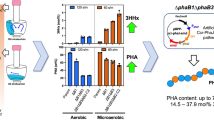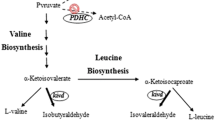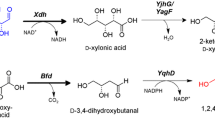Abstract
1-Butanol (1-BD) is a promising fuel additive which can be biosynthesized via reversed β-oxidation pathway in bacteria. However, heterologous reversed β-oxidation pathway is a carbon chain prolongation process with several genes overexpressed in most of bacterial hosts, leading to low titer of 1-BD and high cost for production. Here we displayed a forward β-oxidation pathway for 1-BD production in a kitchen waste oil (KWO) degrading Pseudomonas aeruginosa PA-3, and we proved that aldehyde dehydrogenase (ALDH) is a checkpoint for diverting metabolic flux into 1-BD biosynthesis. With nitrogen source supplied, titer of 1-BD was increased accompanied with 12 ALDH coding genes transcriptionally promoted to different degrees. At the same time, binding energies of these ALDHs with different length of acyl-CoAs in β-oxidation were calculated to identify their specificities. Based on the above information, ALDH deletions were conducted. We certified that deletion of ALDH8 and ALDH9 led to significant decreased titers of 1-BD. Finally, these two ALDHs were separately overexpressed in PA-3, and titer of 1-BD was promoted to 1.36 g/L at 72 h in shake flask. Totally in this work, we provided a forward β-oxidation pathway for 1-BD production from KWO, and the roles of ALDHs were confirmed.






Similar content being viewed by others
Abbreviations
- KWO:
-
Kitchen waste oil
- ALDH:
-
Aldehyde dehydrogenase
- ADHP:
-
Alcohol dehydrogenase
- 1-BD:
-
1-Butanol
- AA:
-
Amino acid
References
Mohan, S. V., Nikhil, G., Chiranjeevi, P., Reddy, C. N., Rohit, M., Kumar, A. N., & Sarkar, O. (2016). Waste biorefinery models towards sustainable circular bioeconomy: Critical review and future perspectives. Bioresource Technology, 215, 2–12.
Sticklen, M. B. (2008). Plant genetic engineering for biofuel production: Towards affordable cellulosic ethanol. Nature Reviews Genetics, 9(6), 433–443.
Wang, M., Liu, L., Fan, L., & Tan, T. (2017). CRISPRi based system for enhancing 1-butanol production in engineered Klebsiella pneumoniae. Process Biochemistry, 56, 139–146.
Nielsen, D. R., Yoon, S. H., Yuan, C. J., & Prather, K. L. (2010). Metabolic engineering of acetoin and meso-2, 3-butanediol biosynthesis in E. coli. Biotechnology Journal, 5(3), 274–284.
Nanthagopal, K., Ashok, B., Saravanan, B., Patel, D., Sudarshan, B., & Ramasamy, R. A. (2018). An assessment on the effects of 1-pentanol and 1-butanol as additives with Calophyllum Inophyllum biodiesel. Energy Conversion and Management, 158, 70–80.
Nawab, S., Wang, N., Ma, X., & Huo, Y.-X. (2020). Genetic engineering of non-native hosts for 1-butanol production and its challenges: A review. Microbial Cell Factories, 19, 1–16.
Prapaporn, B. (2007). Applications of microemulsions in cosmetics. Journal of Cosmetic Dermatology, 6(4), 223–228.
Srinivasan, K., Palanivelu, K., & Gopalakrishnan, A. N. (2007). Recovery of 1-butanol from a model pharmaceutical aqueous waste by pervaporation. Chemical Engineering Science, 62(11), 2905–2914.
Atsumi, S., & Liao, J. C. (2008). Directed evolution of Methanococcus jannaschii citramalate synthase for biosynthesis of 1-propanol and 1-butanol by Escherichia coli. Applied and Environmental Microbiology, 74(24), 7802–7808.
Horn, S. J., Nguyen, Q. D., Westereng, B., Nilsen, P. J., & Eijsink, V. G. (2011). Screening of steam explosion conditions for glucose production from non-impregnated wheat straw. Biomass and Bioenergy, 35(12), 4879–4886.
Koutinas, A., Arifeen, N., Wang, R., & Webb, C. (2007). Cereal-based biorefinery development: Integrated enzyme production for cereal flour hydrolysis. Biotechnology and Bioengineering, 97(1), 61–72.
Parajuli, R., Dalgaard, T., Jørgensen, U., Adamsen, A. P. S., Knudsen, M. T., Birkved, M., Gylling, M., & Schjørring, J. K. (2015). Biorefining in the prevailing energy and materials crisis: A review of sustainable pathways for biorefinery value chains and sustainability assessment methodologies. Renewable and Sustainable Energy Reviews, 43, 244–263.
Dong, H., Zhao, C., Zhang, T., Zhu, H., Lin, Z., Tao, W., Zhang, Y., & Li, Y. (2017). A systematically chromosomally engineered Escherichia coli efficiently produces butanol. Metabolic Engineering, 44, 284–292.
Li, Y., Cui, T., Wang, Y., & Ge, X. (2018). Isolation and characterization of a novel bacterium Pseudomonas aeruginosa for biofertilizer production from kitchen waste oil. RSC Advances, 8(73), 41966–41975.
Sun, A., Cheng, Y., Zhang, Y., Zhang, Q., Wang, S., Tian, S., Zou, Y., Hu, K., Ren, J., & Ge, J. (2014). Aldehyde dehydrogenase 2 ameliorates doxorubicin-induced myocardial dysfunction through detoxification of 4-HNE and suppression of autophagy. Journal of Molecular and Cellular Cardiology, 71, 92–104.
Tuck, L. R., Altenbach, K., Ang, T. F., Crawshaw, A. D., Campopiano, D. J., Clarke, D. J., & Marles-Wright, J. (2016). Insight into coenzyme A cofactor binding and the mechanism of acyl-transfer in an acylating aldehyde dehydrogenase from Clostridium phytofermentans. Scientific Reports, 6(1), 22108.
Zarzycki, J., Sutter, M., Cortina, N. S., Erb, T. J., & Kerfeld, C. A. (2017). In vitro characterization and concerted function of three core enzymes of a glycyl radical enzyme-associated bacterial microcompartment. Scientific Reports, 7(1), 1–12.
Kovach, M. E., Elzer, P. H., Hill, D. S., Robertson, G. T., Farris, M. A., Roop II, R. M., & Peterson, K. M. (1995). Four new derivatives of the broad-host-range cloning vector pBBR1MCS, carrying different antibiotic-resistance cassettes. Gene, 166(1), 175–176.
Wang, X., Zhang, L., Xi, B., Sun, W., Xia, X., Zhu, C., He, X., Li, M., Yang, T., & Wang, P. (2015). Biogas production improvement and C/N control by natural clinoptilolite addition into anaerobic co-digestion of Phragmites australis, feces and kitchen waste. Bioresource Technology, 180, 192–199.
Wang, M., Fan, L., & Tan, T. (2014). 1-Butanol production from glycerol by engineered Klebsiella pneumoniae. RSC Advances, 4(101), 57791–57798.
Zhang, J., Zong, W., Hong, W., Zhang, Z.-T., & Wang, Y. (2018). Exploiting endogenous CRISPR-Cas system for multiplex genome editing in Clostridium tyrobutyricum and engineer the strain for high-level butanol production. Metabolic Engineering, 47, 49–59.
Sampson, E. M., & Bobik, T. A. (2008). Microcompartments for B12-dependent 1, 2-propanediol degradation provide protection from DNA and cellular damage by a reactive metabolic intermediate. Journal of Bacteriology, 190(8), 2966–2971.
Jorda, J., Lopez, D., Wheatley, N. M., & Yeates, T. O. (2013). Using comparative genomics to uncover new kinds of protein-based metabolic organelles in bacteria. Protein Science, 22(2), 179–195.
Bobik, T. A., Havemann, G. D., Busch, R. J., Williams, D. S., & Aldrich, H. C. (1999). The propanediol utilization (pdu) operon of Salmonella enterica Serovar Typhimurium LT2 includes genes necessary for formation of polyhedral organelles involved in coenzyme B12-dependent 1, 2-propanediol degradation. Journal of Bacteriology, 181(19), 5967–5975.
Petit, E., LaTouf, W. G., Coppi, M. V., Warnick, T. A., Currie, D., Romashko, I., Deshpande, S., Haas, K., Alvelo-Maurosa, J. G., & Wardman, C. (2013). Involvement of a bacterial microcompartment in the metabolism of fucose and rhamnose by Clostridium phytofermentans. PLoS One, 8(1), e54337.
Chen, C., Sun, N., Li, D., Long, S., Tang, X., Xiao, G., & Wang, L. (2018). Optimization and characterization of biosurfactant production from kitchen waste oil using Pseudomonas aeruginosa. Environmental Science and Pollution Research, 25(15), 14934–14943.
Tetko, I. V., & Bruneau, P. (2004). Application of ALOGPS to predict 1-octanol/water distribution coefficients, logP, and logD, of AstraZeneca in-house database. Journal of Pharmaceutical Sciences, 93(12), 3103–3110.
Mills, P., Magnusson, B., & Cross, S. (2004). The effect of region of application on absorption of ethanol and hexanol through canine skin. Research in Veterinary Science, 76(1), 37–41.
Ishige, T., Tani, A., Sakai, Y., & Kato, N. (2000). Long-chain aldehyde dehydrogenase that participates in n-alkane utilization and wax ester synthesis in Acinetobacter sp. strain M-1. Applied and Environmental Microbiology, 66(8), 3481–3486.
Funding
This work was financially supported by Beijing Municipal Education Commission Technology Plan (KM202011417006), Project of Beijing Municipal Commission of Education (KZ201911417049), Premium Funding Project for Academic Human Resources Development in Beijing Union University (BPHR2018BZ01), and China Scholarship Council Project (201908110070).
Author information
Authors and Affiliations
Corresponding author
Ethics declarations
Conflict of Interest
The authors declare that they have no conflict of interest.
Additional information
Publisher’s Note
Springer Nature remains neutral with regard to jurisdictional claims in published maps and institutional affiliations.
Supplementary Information
ESM 1
(DOCX 25 kb).
Rights and permissions
About this article
Cite this article
Li, Y., Liu, Z. & Ge, X. Metabolic Checkpoint Aldehyde Dehydrogenases Are Important for Diverting β-Oxidation into 1-Butanol Biosynthesis from Kitchen Waste Oil in Pseudomonas aeruginosa. Appl Biochem Biotechnol 193, 730–742 (2021). https://doi.org/10.1007/s12010-020-03456-x
Received:
Accepted:
Published:
Issue Date:
DOI: https://doi.org/10.1007/s12010-020-03456-x




